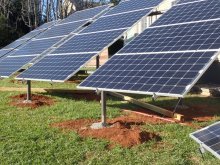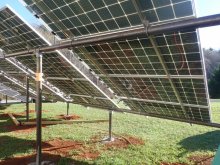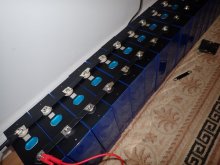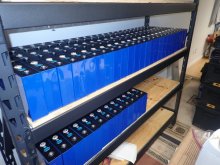You are using an out of date browser. It may not display this or other websites correctly.
You should upgrade or use an alternative browser.
You should upgrade or use an alternative browser.
Very new to solar but started purchasing items, not sure of the final specs of the whole system.
- Thread starter kromc5
- Start date
Bleedingblue
Solar Enthusiast
- Joined
- May 12, 2020
- Messages
- 545
Had a surprise this evening, I really researched batteries and talked to all that were mentioned and more.
Micheal if paying cash had the best price, others I contacted that were listed here on diy but much higher.
I found two other companies that had great reposes and due to the save a CC I avoided the fees.
Now I need to finally decided on the best way to wire them up and I''m sure I will need the expertise here
on diysolar. If you can guess how many you win a free rejuvenating one week trip to camp solarwonderful, hard labor running the
post hole digger and free fun for all wiring the system.
Once I test them and verify they are good will mention the seller.
how many cells is that? What AH?
It is 128 cells 280ah, the packaging was perfect, even had one box completely punctured / torn open on one side but they used 3 layers. So far none of the batteries had the slightets dent etc.how many cells is that? What AH?
Bleedingblue
Solar Enthusiast
- Joined
- May 12, 2020
- Messages
- 545
It is 128 cells 280ah, the packaging was perfect, even had one box completely punctured / torn open on one side but they used 3 layers. So far none of the batteries had the slightets dent etc.
Thats a big bank. Exactly 2x as many as me. I assume its a 48 volt system.
Thats 114,688 wh lol hope you have enough solar power during the day to fill the batteries up
Thats a big bank. Exactly 2x as many as me. I assume its a 48 volt system.
Thats 114,688 wh lol hope you have enough solar power during the day to fill the batteries up
We completely finished 36 500w panels today completely mounted: with additional 24 more to install.
The final total will be 60 500w panels plus 2 additional 120 amp charge controllers.
The goal was to go larger and do 75% charge but will have to wait and see what my final nightly numbers will be.
Attachments
Sadly before changes we were constant 44kwh + per evening, the mini split has greatly reduced usage and the next thing to save up for is the hybrid water heater. I also added motion sensing bulbs upstairs and that has surprisingly helped as well.It's lithium. He doesn't HAVE to fill it up.
Fine to drain for all 28 days of a polar night, then take a month to recharge.
He's good for 4 kWh per day in his igloo.
Hedges
I See Electromagnetic Fields!
- Joined
- Mar 28, 2020
- Messages
- 20,689
My yard lights are a surprisingly large consumer. Plan is to wire load-shed relay when running on batteries.
Hybrid water heater robs peter to pay paul. What is the heat source feeding it?
Ideally a large tank and heater only runs on surplus power during the day. My guess is PV panels are cheaper than a hybrid water heater.
I'd like to store hot and cold for HVAC in thermal mass, but that is more involved, needs larger tanks. Phase change for cooling is cheap enough, but for heating need either large mass or high temperature.
My consumption and deployed PV is similar to yours. So long as the grid is up my storage is accounting and I heat with credits I've banked. It is only for peak times that I'd like to use thermal storage. Maybe a chest freezer full of ice, but not sure it can freeze it all in 15 hours. BTU/h of the freezer isn't going to be 25% of my A/C (to provide cooling from 3:00 PM to 7:00 PM) so may need larger system. Ideally the central A/C could be diverted to build ice some hours, but too much re-plumbing of refrigerant.
Hybrid water heater robs peter to pay paul. What is the heat source feeding it?
Ideally a large tank and heater only runs on surplus power during the day. My guess is PV panels are cheaper than a hybrid water heater.
I'd like to store hot and cold for HVAC in thermal mass, but that is more involved, needs larger tanks. Phase change for cooling is cheap enough, but for heating need either large mass or high temperature.
My consumption and deployed PV is similar to yours. So long as the grid is up my storage is accounting and I heat with credits I've banked. It is only for peak times that I'd like to use thermal storage. Maybe a chest freezer full of ice, but not sure it can freeze it all in 15 hours. BTU/h of the freezer isn't going to be 25% of my A/C (to provide cooling from 3:00 PM to 7:00 PM) so may need larger system. Ideally the central A/C could be diverted to build ice some hours, but too much re-plumbing of refrigerant.
We are all electric but you have to take into account our job which by its nature we use more electricity and water than the majority of homes. We currently have a 50 gallon and I would like to go to an 80 gallon hybrid. Sometimes depending on circumstances 6+ showers a day can occur. Not to mention before the majority of the lights would be turned on during the night and left on. We also have a generator for backup as we make a lot of meals and have been buying in bulk to save money, I will need learn how to hookup the generator from ac to dc for the batteries just as a precautionary backup.My yard lights are a surprisingly large consumer. Plan is to wire load-shed relay when running on batteries.
Hybrid water heater robs peter to pay paul. What is the heat source feeding it?
Ideally a large tank and heater only runs on surplus power during the day. My guess is PV panels are cheaper than a hybrid water heater.
I'd like to store hot and cold for HVAC in thermal mass, but that is more involved, needs larger tanks. Phase change for cooling is cheap enough, but for heating need either large mass or high temperature.
My consumption and deployed PV is similar to yours. So long as the grid is up my storage is accounting and I heat with credits I've banked. It is only for peak times that I'd like to use thermal storage. Maybe a chest freezer full of ice, but not sure it can freeze it all in 15 hours. BTU/h of the freezer isn't going to be 25% of my A/C (to provide cooling from 3:00 PM to 7:00 PM) so may need larger system. Ideally the central A/C could be diverted to build ice some hours, but too much re-plumbing of refrigerant.
Last edited:
I'm not familiar with that but will reseach that and see how that could be implemented.How about a resistance water heater as a pre-heater, enabled whenever surplus power is available. That would improve recovery time for the main water heater and reduce its power draw.
Hedges
I See Electromagnetic Fields!
- Joined
- Mar 28, 2020
- Messages
- 20,689
Pre-heat is usually done with solar thermal.
I assume you'll have excess electric power at times, which makes it easy to concentrate in a conventional water heater.
Add a couple valves and you can also use it a redundant spare heater, can isolate the other if disconnected for repair.
Just check what maximum inlet temperature is allowed for your main heater.
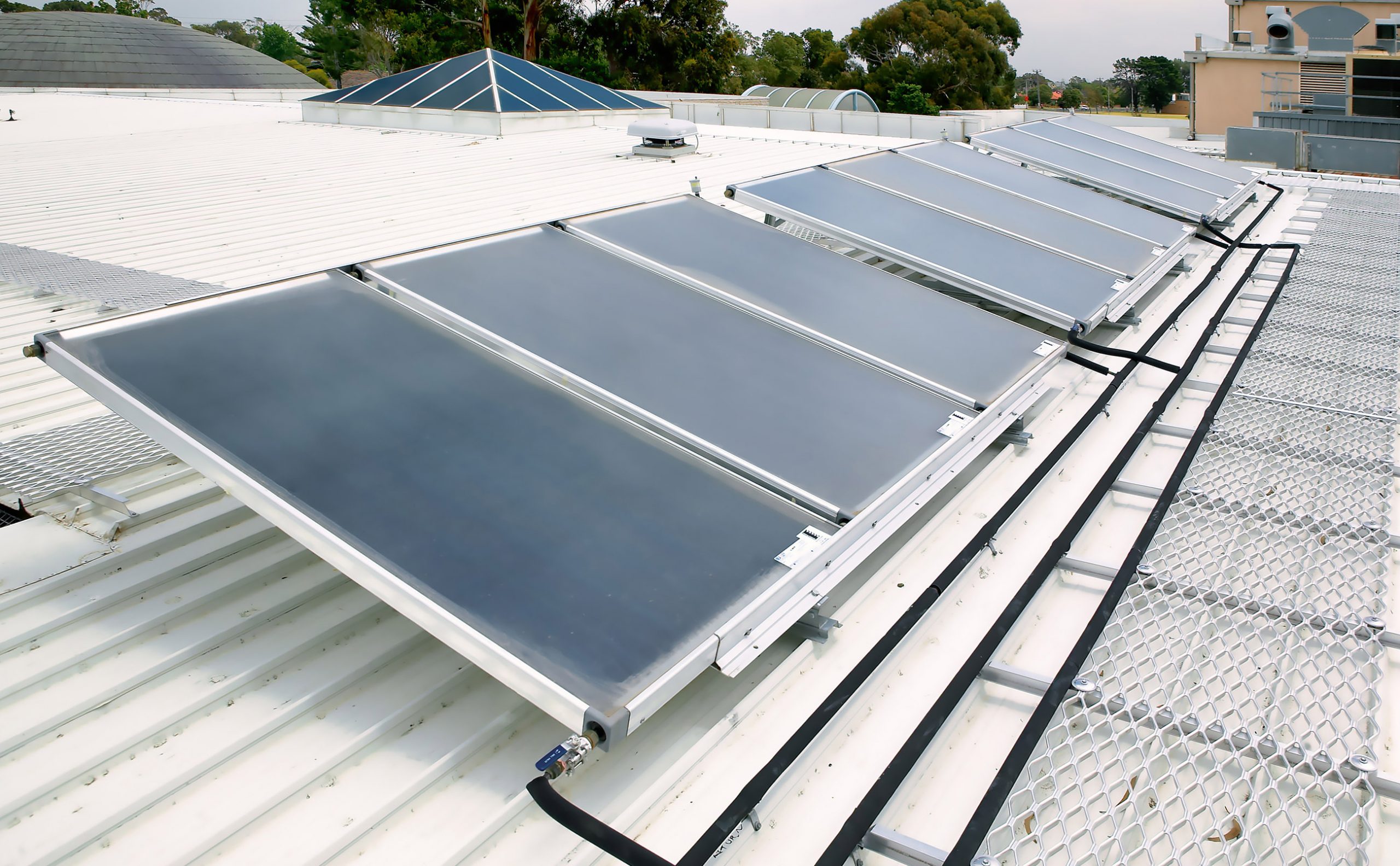
 www.rinnai.com.au
www.rinnai.com.au
I assume you'll have excess electric power at times, which makes it easy to concentrate in a conventional water heater.
Add a couple valves and you can also use it a redundant spare heater, can isolate the other if disconnected for repair.
Just check what maximum inlet temperature is allowed for your main heater.

Solar Pre-Heat Systems
Rinnai has an extensive range of hot water systems that cater to all Australian households, including solar hot water & hot water storage.
Last night I was trying to draw the battery connections, inverter and charge controllers. Midnite makes a battery combiner but I was unsure of the total connections and I came across this company.
 www.bluesea.com
www.bluesea.com
My thoughts were I have plenty of connections for the 8 16s, charge controllers and inverter.
PowerBar 1000 - 12 3/8" Terminal Studs - Blue Sea Systems
Complex wiring systems require a single point to consolidate largeand small conductors. The PowerBar 1000 offers a 1,000 Ampbusbar with various size studs and screws to connect conductors andfuse blocks.
My thoughts were I have plenty of connections for the 8 16s, charge controllers and inverter.
Top Balance is not going to well, should have tested the charger, its only pushing out 2 amps even though its reading over 10. After 5 hours its only up one hundredths of a volt. Anyone have a recommendation for a charger? I found that chargery makes dc chargers but are close to 300 without shipping. Cut some wood panels and the batteries are much more level now.
Attachments
Hedges
I See Electromagnetic Fields!
- Joined
- Mar 28, 2020
- Messages
- 20,689
1) How many batteries in parallel, and how many amp hours per battery? What "C" rate are you giving them? 2A/(Ah per cell X number of cells)Top Balance is not going to well, should have tested the charger, its only pushing out 2 amps even though its reading over 10. After 5 hours its only up one hundredths of a volt. Anyone have a recommendation for a charger? I found that chargery makes dc chargers but are close to 300 without shipping. Cut some wood panels and the batteries are much more level now.
2) Lithium batteries have a flat middle portion, so even if accepting 2A/40 batteries = 50 mA per battery, voltage will be slow to rise. Is that perhaps 50 mA x 5 hours = 0.25 Ah out of 100 Ah or 280 Ah capacity?
Even temperature variations of battery and supply may swamp out changes in state of charge.
Patience.
"its only pushing out 2 amps even though its reading over 10"
Meaning you set it to 10A limit, and it is delivering 2A?
What voltage limit did you set it to, and what is it delivering?
I would expect supply to sit at voltage limit, or sit at current limit.
Display says 3.86V, 10.29A
Is that the limit setting, or what it is delivering right now?
Where do you get 2A?
What is voltage now?
"It is recommended you charge to 3.5 or 3.6V per cell"
Technical Information LiFePO4 Care Guide: Looking after your lithium batteries
LiFePO4 Care Guide: Looking after your lithium batteries - Technical Information LiFePO4 Care Guide: Looking after your lithium batteries
For anyone curse the mini split greatly reduced on usage:
I have 16, the Display says 3.86V, 10.29A is the max output, measured two amps at the wire connection coming out of the charger. The voltage shown on the display matches but not the amps. If I turn to 3.6v its only 1.6 amps which considering the total batteries its going to be a longtime before complete.1) How many batteries in parallel, and how many amp hours per battery? What "C" rate are you giving them? 2A/(Ah per cell X number of cells)
2) Lithium batteries have a flat middle portion, so even if accepting 2A/40 batteries = 50 mA per battery, voltage will be slow to rise. Is that perhaps 50 mA x 5 hours = 0.25 Ah out of 100 Ah or 280 Ah capacity?
There was another forum member top balancing a very large number of batteries. One of the suggestions was to put the leads from the charger at opposite ends of the battery string. I can't say one way or another on that suggestion, but it seemed legitimate to me.
Hedges
I See Electromagnetic Fields!
- Joined
- Mar 28, 2020
- Messages
- 20,689
So you are applying 3.86V to the batteries. 16 batteries are drawing 2.0A, about 120 mA each.For anyone curse the mini split greatly reduced on usage:
I have 16, the Display says 3.86V, 10.29A is the max output, measured two amps at the wire connection coming out of the charger. The voltage shown on the display matches but not the amps. If I turn to 3.6v its only 1.6 amps which considering the total batteries its going to be a longtime before complete.
Is 3.86 the final voltage you want to apply to the batteries? How many hours at 3.86V is considered fully charged? Or, what tail current is considered fully charged?
They may be fully charged already. Keeping them at that voltage after full charge may be overcharging them.
What do you consider "charging complete"?

Similar threads
- Replies
- 52
- Views
- 4K



